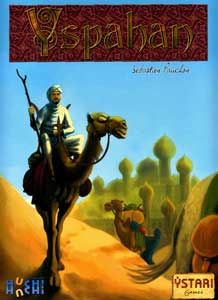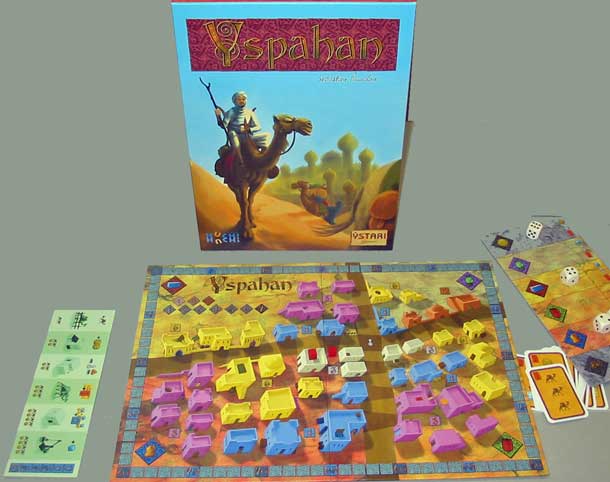Pevans
YspahanReviewed by Pevans |
 It took me a while to work out that Yspahan, the medieval Persian city that the game is named after, is better known in English as Isfahan. The theme of the game follows from the city’s importance at the junction of trading routes across the Middle East. The small board shows the city divided into four sections around a crossroads. A second board has a train of camels winding across it. A third board shows the actions available each turn. Each player gets a little board of their own as well. These show the same sequence of buildings with their cost (in camels and gold) and their function.
It took me a while to work out that Yspahan, the medieval Persian city that the game is named after, is better known in English as Isfahan. The theme of the game follows from the city’s importance at the junction of trading routes across the Middle East. The small board shows the city divided into four sections around a crossroads. A second board has a train of camels winding across it. A third board shows the actions available each turn. Each player gets a little board of their own as well. These show the same sequence of buildings with their cost (in camels and gold) and their function.
Players have a set of cubes in their colour and will score points for placing these appropriately on the various boards. Then there are yellow wooden discs for gold and brown wooden camel-shaped pieces for … camels. There is also a substantial pile of dice: nine white and three yellow. These control what options are available to the players each turn. This is a rather clever mechanism that frustrates all the players!
Yspahan is played over three “weeks” of seven turns (“days”) with points scored at the end of each week. As going first is a definite advantage, a special rule for the last turn provides balance for games with four players. The first player in the turn rolls the white dice (and can add yellow ones by paying gold). They divide the dice according to their value. The top set – usually, but not always, the sixes – goes on the top row of the actions for the turn. The lowest number goes on the bottom row with the others stacking up on this. Only if all six numbers are rolled will all the rows be occupied – and all the actions be available to the players.
The first player then chooses an action to take. The top action gives them more gold: as many as there are dice on that row. The bottom row gives whoever takes it more camels: as many as there are dice on the row. The four middle rows refer to the sections of the city, with the smallest and most valuable section being the highest of the four rows. As you will have guessed by now, the player puts as many cubes into the area as there are dice on the row. Each section in the city has several groups of houses (in different colours), worth more points according to how few are in the group. At the end of the week, players will score the points for groups that are wholly occupied by their cubes.
Each action offers players two options instead of the main action. One of these is to take an action card, which can be played at any point in a player’s turn. These give players tactical advantages (taking extra gold or camels, for instance). A card can also be used as an extra die when you choose your action. The second option is to move the supervisor pawn, which starts on the crossroads in the middle of the city. It moves as many spaces as the spots on the dice selected – and players can pay gold to move it further or fewer spaces. If it ends outside an occupied house, that cube is moved to the camel train and immediately scores its owner some points. A neat tactical ploy is that a player can throw in a camel to place a cube from their supply instead, preserving their position in the city as well as scoring for the camel train.
You can immediately see why playing first in the turn is an advantage. It gives you the greatest choice of actions. The row with the most dice on is usually very tempting, but players can have all sorts of tactical reasons for taking other options. Being last to choose may mean you have few options, but you can always take a card. And cards are almost always useful.
Having taken their action, players can then spend camels and gold for the buildings on their personal board – placing a cube to show an active building. Each building gives players some advantage and can also be worth points. You get none for the first two, but 5 each for the next three and 10 for the sixth and last building, if you take it. When I first played the game, I thought getting all the buildings would make a significant difference. However, my experience is that all the players end up with most, if not all, of their buildings by the end of the game.
The real advantage of the buildings is in what they provide for players. The cheapest two give you more camels and gold when you take the respective action. The most expensive two allow you to place an extra cube when claiming houses in the city and to score extra points for groups of houses. One of the middle two allows you to adjust the supervisor’s move by up to three spaces without payment. The last means you get a card every time you add a camel to the train. As I’ve mentioned, cards are pretty useful, so getting this ability early on can be a game-winning advantage.

Once everybody’s taken their turn, the turn start moves on. After seven turns, it’s time to score. Players get points for complete groups of houses in the sections of the city and more points for the camel train. This depends on how many cubes they have there and which level the highest one is on. As they score more than once and stay between weeks, adding cubes to the camel train is very useful. It’s even more useful if other people are adding cubes: it makes it easier to get a cube on a higher level. However, if the camel train is filled during a turn, it is scored and cleared. This can actually be bad news for someone with lots of cubes there as they have to build up their position again.
Yspahan is a game that provides lots of different ways of scoring points. So there’s no one way of winning. Balancing your options clearly makes sense. It’s also worth looking at what the other players are doing. Like a lot of games, there’s an advantage in doing what the others aren’t. It means less competition and more opportunity for points. However, your options each turn are limited by the dice. So the game is very tactical: it’s about taking advantage of your options for what you play each ‘day’ to make the most of your scoring opportunities at the end of the ‘week’.
This is not a particularly deep game, but it is challenging. The challenge is in making the most of what the dice give you. This isn’t just different each game (though most of mine seem to have a shortage of camels), it’s different every turn! This is not something I realised the first time I played Yspahan, but I have appreciated the game more each time I’ve played it. It well deserves its place on the shortlist for this year’s Spiel des Jahres (Game of the Year in Germany). And it’s also one of the games for this year’s EuropeMasters tournament in October. It gets 9/10 on my highly subjective scale.
Yspahan was designed by Sébastien Pauchon and is published by Ystari Games (in France – Rio Grande publishes an English language edition). It is a tactical board game for 3-4 players (rules for two players are available on the Ystari website), aged 8+ and takes about 60 minutes to play.
This review was first published in TWJO 77, August 2007. A version was also published in Flagship 123, November 2007.